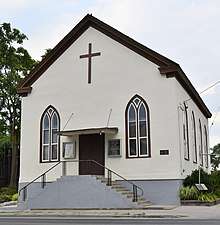St. Catharines
St. Catharines is the largest city in Canada's Niagara Region and the sixth largest urban area in the province of Ontario, with 96.13 square kilometres (37.1 sq mi) of land and 133,113 residents in 2016. It lies in Southern Ontario, 51 kilometres (32 mi) south of Toronto across Lake Ontario, and is 19 kilometres (12 mi) inland from the international boundary with the United States along the Niagara River. It is the northern entrance of the Welland Canal. Residents of St. Catharines are known as St. Cathariners. St. Catharines carries the official nickname "The Garden City" due to its 1,000 acres (4 km2) of parks, gardens, and trails.
St. Catharines | |
|---|---|
| City of St. Catharines | |
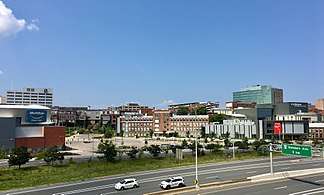 Downtown St. Catharines | |
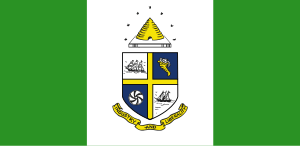 Flag | |
| Nickname(s): The Garden City, St. Kitts, St. Cats, The Kitts | |
| Motto(s): Industry and Liberality | |
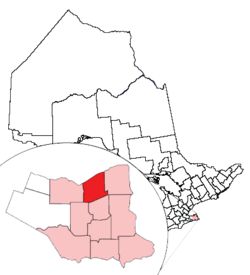 Location of St. Catharines and its census metropolitan area in Ontario | |
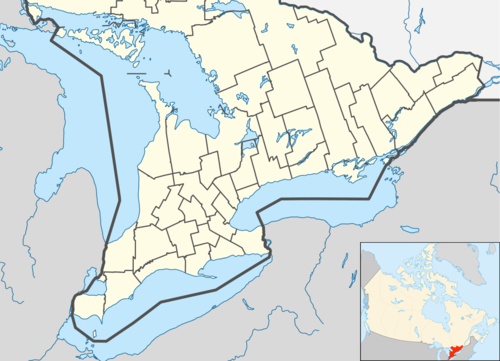 St. Catharines Location of St. Catharines in Southern Ontario | |
| Coordinates: 43°11′N 79°14′W | |
| Country | Canada |
| Province | Ontario |
| Region | Niagara |
| Settled | 1779 |
| Incorporated | 1845 (town) |
| 1876 (city) | |
| Government | |
| • Mayor | Walter Sendzik |
| • Governing body | St. Catharines City Council |
| • MPs | Chris Bittle, Vance Badawey, Dean Allison |
| • MPPs | Jennie Stevens, Jeff Burch, Sam Oosterhoff |
| Area | |
| • Land | 96.13 km2 (37.12 sq mi) |
| • Urban | 378.68 km2 (146.21 sq mi) |
| • Metro | 1,397.51 km2 (539.58 sq mi) |
| Elevation | 97.80 m (320.87 ft) |
| Population | |
| • City (lower-tier) | 133,113 (Ranked 38th) |
| • Density | 1,384.8/km2 (3,587/sq mi) |
| • Urban | 309,319 (Ranked 12th) |
| • Urban density | 816.8/km2 (2,116/sq mi) |
| • Metro | 406,074 (Ranked 12th) |
| • Metro density | 280.6/km2 (727/sq mi) |
| Time zone | UTC−5 (Eastern (EST)) |
| • Summer (DST) | UTC−4 (EDT) |
| Forward Sortation Area | L2M to L2W |
| Area code(s) | 905, 289, 365 |
| Highways | |
| Website | stcatharines |
St. Catharines is between the Greater Toronto and Hamilton Area (GTHA) and the Canada–U.S. border at Fort Erie. Manufacturing is the city's dominant industry, as noted by the heraldic motto, "Industry and Liberality". General Motors of Canada, Ltd., the Canadian subsidiary of General Motors, was the city's largest employer, a distinction now held by the District School Board of Niagara. THK Rhythm Automotive, formerly TRW, operates a plant in the city, though in recent years employment there has shifted from heavy industry and manufacturing to services.
St. Catharines lies on one of the main telecommunications backbones between Canada and the United States, and as a result a number of call centres operate in the city. It is designated an Urban Growth Centre by the Growth Plan for the Greater Golden Horseshoe, intended to achieve a minimum density target of 150 jobs and residents combined per hectare by 2032 or earlier.[6]
History
The city was first settled by Loyalists in the 1780s. The Crown granted land in compensation for services and for losses in the United States. Early histories credit Serjeant Jacob Dittrick and Private John Hainer, formerly of Butler's Rangers, as among the first to come to the area. They took their Crown Patents where Dick's Creek and 12 Mile Creek merge, now the city centre of St. Catharines. Although never documented, some local St. Catharines historians speculate that Dick's Creek was named after Richard Pierpoint, a Black Loyalist and former American slave. Secondary to water routes, native trails provided transportation networks, resulting in the present-day radial road pattern from the City centre. The surrounding land was surveyed and Townships created between 1787 and 1789.
After the Butler's Rangers disbanded in 1784 and settled the area, Duncan Murray as a former Quartermaster in the 84th Regiment of Foot (Royal Highland Emigrants) was appointed by the Crown to distribute free Government supplies (victuals) for 2 years to the resettled Loyalists.[7] He did this from his mill, built on the 12 Mile Creek in Power Glen. After his death in 1786, his holdings were forfeited to merchant Robert Hamilton of Queenston.
Hamilton tried to operate for profit the already well-established Murray's Distribution Centre and Mill under the management of his cousin. Among other ventures, Hamilton became land wealthy, expropriating lands from subsistence Loyalist settlers who were incapable of settling their debts.[8] Murray's distribution centre, later Hamilton's warehouse, and its location have long been a mystery. Hamilton's major profits were derived from transhipping supplies for the military and civic establishments from his Queenston enterprise, not from charitably supplying the subsistence Loyalist settlers. Hamilton lacked interest in social development[9] and sold his business to Jesse Thompson before the turn of the 18th century.
The small settlement was known as "The Twelve" and as "Murray's District" to military and civic officials, but the local residents in 1796 and earlier referred to it as St. Catharines.[10] This is confirmed in St. Catharines' first history, written by J. P. Merritt: "to be historically accurate the name St. Catharines preceded all of these ..."[11]
The Merritt family arrived after this time, among the later Loyalists to relocate following the American Revolution. They were from the Carolinas, New York state and New Brunswick. In 1796, Thomas Merritt arrived to build on his relationship with his former Commander and Queen's Ranger, John Graves Simcoe, now the Lieutenant Governor of Upper Canada.[12]
At an unknown early date, an inn was built by Thomas Adams on the east side of what is now Ontario Street. It became a community meeting place, election centre, stagecoach stop, and mail delivery deposit. This was preceded by the church and a log school house completed before 1797,[13] all on the east bank of the 12 Mile Creek at the extreme west end of what was known at that time as Main Street. This was an extension of the old Iroquois Trail and was renamed St. Paul Street by the settlers and descendant by the mid-19th century. Several mills, salt works, numerous retail outlets, a ship building yard, distillery and various other businesses were developed next.
The first Welland Canal was constructed from 1824 to 1833 behind what is now known as St. Paul Street, using Twelve Mile and Dick's Creek. William Hamilton Merritt worked to promote the ambitious venture, both by raising funds and by enlisting government support. The canal established St. Catharines as the hub of commerce and industry for the Niagara Peninsula.
Incorporated as a village in 1845, St. Catharines had a population of about 3500 in 1846. The primary industry was flour milling. Other industry included ship repairs, four grist mills, a brewery, three distilleries, a tannery, a foundry, a machine and pump factory. There were tradesmen of many types, three bank agencies, and eight taverns. The train had not yet arrived but stage coaches offered service to other towns and villages. There were already six churches or chapels, a post office that received mail daily, a grammar school and a weekly newspaper.[14]
William Hamilton Merritt played a role in making St. Catharines a centre of abolitionist activity. In 1855, the British Methodist Episcopal Church, Salem Chapel was established at the corner of Geneva and North streets, on land granted to the congregation by Merritt in the early 1840s. The area became known to refugee slaves from the United States as a place of "refuge and rest"; it was a destination, one of the final stops in Canada on the Underground Railroad for refugee African-American slaves. During this time, abolitioniast Harriet Tubman lived in St. Catharines.[15][16] By the mid-1850s, the town's population was about six thousand, 800 of whom were of African descent.[17] St. Catharines remains an important place in Black Canadian history.
St. Catharines was incorporated as a city in 1876.
The St. Catharines Armoury is a recognized Federal Heritage building, #1991 on the Register of the Government of Canada Heritage Buildings.[18]
Geography and climate
Climate
St. Catharines' climate is humid continental (Köppen borderline Dfa/Dfb).[19] It has a unique micro-climate because of the moderating influence of Lake Ontario/Lake Erie and the sheltering effect of the Niagara Escarpment to the south; these allow wineries to flourish.[20] As a result, the city records numerous frost-free days and frequent thaws in the winter, although it sometimes receives heavy lake-effect snow during certain wind conditions, and micro-cooling lakeside on some spring afternoons. The summer season is predominantly warm, and sometimes hot, with an average high temperature of 27 °C (81 °F) in July. Summer thunderstorms are commonplace but generally less prevalent and less severe than further west in southern Ontario due to the diminishing effect of the surrounding lakes.
The highest temperature ever recorded in St. Catharines was 40.0 °C (104 °F) on 10 July 1936.[21] The coldest temperature ever recorded was −25.7 °C (−14.3 °F) on 18 February 1979.[22]
| Climate data for St. Catharines Airport, 1981–2010 normals, extremes 1911–present[lower-alpha 1] | |||||||||||||
|---|---|---|---|---|---|---|---|---|---|---|---|---|---|
| Month | Jan | Feb | Mar | Apr | May | Jun | Jul | Aug | Sep | Oct | Nov | Dec | Year |
| Record high humidex | 20.8 | 20.2 | 29.3 | 34.5 | 43.5 | 44.5 | 46.1 | 49.4 | 42.0 | 39.0 | 27.1 | 25.0 | 49.4 |
| Record high °C (°F) | 20.0 (68.0) |
19.4 (66.9) |
26.7 (80.1) |
32.2 (90.0) |
35.0 (95.0) |
36.1 (97.0) |
40.0 (104.0) |
38.3 (100.9) |
36.7 (98.1) |
31.1 (88.0) |
25.0 (77.0) |
21.9 (71.4) |
40.0 (104.0) |
| Average high °C (°F) | −0.3 (31.5) |
0.9 (33.6) |
5.5 (41.9) |
12.4 (54.3) |
19.5 (67.1) |
24.4 (75.9) |
27.1 (80.8) |
25.8 (78.4) |
21.6 (70.9) |
15.1 (59.2) |
8.4 (47.1) |
2.5 (36.5) |
13.6 (56.5) |
| Daily mean °C (°F) | −3.8 (25.2) |
−2.9 (26.8) |
1.1 (34.0) |
7.4 (45.3) |
13.7 (56.7) |
19.0 (66.2) |
21.9 (71.4) |
20.8 (69.4) |
16.6 (61.9) |
10.4 (50.7) |
4.6 (40.3) |
−0.9 (30.4) |
9.0 (48.2) |
| Average low °C (°F) | −7.4 (18.7) |
−6.8 (19.8) |
−3.3 (26.1) |
2.2 (36.0) |
7.9 (46.2) |
13.4 (56.1) |
16.6 (61.9) |
15.7 (60.3) |
11.6 (52.9) |
5.6 (42.1) |
0.8 (33.4) |
−4.2 (24.4) |
4.4 (39.9) |
| Record low °C (°F) | −23.8 (−10.8) |
−25.7 (−14.3) |
−21.1 (−6.0) |
−15 (5) |
−4.4 (24.1) |
1.0 (33.8) |
6.1 (43.0) |
2.6 (36.7) |
0.0 (32.0) |
−7 (19) |
−13.9 (7.0) |
−24.4 (−11.9) |
−25.7 (−14.3) |
| Record low wind chill | −42.0 | −34.6 | −28.3 | −19.7 | −2.9 | 0.0 | 0.0 | 0.0 | 0.0 | −8.3 | −18.9 | −28.0 | −42.0 |
| Average precipitation mm (inches) | 65.2 (2.57) |
54.9 (2.16) |
61.7 (2.43) |
77.0 (3.03) |
76.8 (3.02) |
85.9 (3.38) |
77.8 (3.06) |
70.3 (2.77) |
90.6 (3.57) |
67.0 (2.64) |
81.6 (3.21) |
71.5 (2.81) |
880.1 (34.65) |
| Average rainfall mm (inches) | 30.8 (1.21) |
28.9 (1.14) |
39.3 (1.55) |
71.2 (2.80) |
76.3 (3.00) |
86.0 (3.39) |
77.8 (3.06) |
70.3 (2.77) |
90.6 (3.57) |
67.0 (2.64) |
72.1 (2.84) |
44.0 (1.73) |
754.2 (29.69) |
| Average snowfall cm (inches) | 38.6 (15.2) |
29.3 (11.5) |
23.2 (9.1) |
5.8 (2.3) |
0.4 (0.2) |
0.0 (0.0) |
0.0 (0.0) |
0.0 (0.0) |
0.0 (0.0) |
0.1 (0.0) |
9.6 (3.8) |
30.1 (11.9) |
137.1 (54.0) |
| Average precipitation days (≥ 0.2 mm) | 16.5 | 13.4 | 13.3 | 13.9 | 11.5 | 10.9 | 9.8 | 9.7 | 10.9 | 11.8 | 14.1 | 15.2 | 150.7 |
| Average rainy days (≥ 0.2 mm) | 5.8 | 5.8 | 8.4 | 12.4 | 11.5 | 10.9 | 9.8 | 9.7 | 10.9 | 11.8 | 12.1 | 8.1 | 117.0 |
| Average snowy days (≥ 0.2 cm) | 12.3 | 9.1 | 6.5 | 2.4 | 0.05 | 0.0 | 0.0 | 0.0 | 0.0 | 0.10 | 3.0 | 9.4 | 42.7 |
| Average relative humidity (%) | 73.0 | 67.7 | 62.9 | 57.6 | 55.9 | 58.1 | 57.5 | 59.0 | 60.5 | 64.5 | 69.1 | 71.9 | 63.1 |
| Mean monthly sunshine hours | 64.5 | 106.8 | 140.5 | 166.5 | 242.3 | 279.9 | 277.6 | 255.3 | 185.0 | 155.2 | 80.5 | 69.3 | 2,023.4 |
| Percent possible sunshine | 22.2 | 36.2 | 38.1 | 41.5 | 53.3 | 60.9 | 59.6 | 59.1 | 49.2 | 45.2 | 27.5 | 24.7 | 43.1 |
| Source: Environment Canada[22][23][21] | |||||||||||||
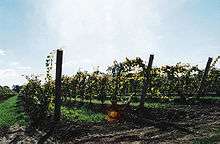
The complex and extensive glacial history of the Niagara Peninsula has resulted in similarly complex soil stratigraphy in the area occupied by the city today. St. Catharines was once at the base of a glacial lake known as Glacial Lake Iroquois, which deposited thick layers of clay between the Escarpment and Lake Ontario. As a result of these factors, the city's soil is particularly conducive to fruit growing and is capable of producing grapes that are used to make award-winning wines. Three wineries operate in the city's west end: Henry of Pelham Winery, Hernder Estates and Harvest Estates.
Since the opening of the first Welland Canal in 1829, the city has had four different canal systems, whether modified or newly constructed, carved into its geographical landscape. The fourth and present-day canal forms the majority of the city's eastern boundary. The first three of the city's canals have largely been buried, portions of it beside the present-day Highway 406 and near Lake Street and the QEW highway.
Other remnants of the original canals can still be seen in various locations throughout the city; many remains are hidden within forested areas designated as city parks. Some residents in the region are interested in restoring the original routing of the Welland Canal through the city. They intend that the restored waterway and locks would be open to a new tourist attraction within the city.
Major parks
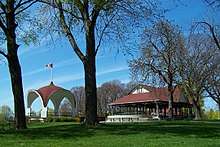
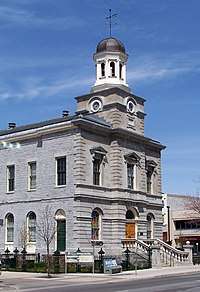
- Montebello Park: Designed by Frederick Law Olmsted in 1887, who was renowned for designing and developing New York City's Central Park in 1853. A commemorative rose garden, with over 1,300 bushes in 25 varieties, is the city's largest rose collection; it features an ornamental fountain. The focal point of the park is a band shell and pavilion built in 1888. The park is designated under the Ontario Heritage Act.
- Lakeside Park: Located in the North end, along the shores of Lake Ontario in the community known as Port Dalhousie. Hosts yearly fireworks displays on 1 July (Canada Day). Has picnic areas, a pavilion, snack bar, change rooms, washrooms, playground equipment, boardwalk, the Lakeside Park Carousel, and public docks for visiting boaters. The beach offers magnificent sunset views over Lake Ontario. Lakeside Park inspired a song by Rush which describes the park itself and Neil Peart's memories there.
- Burgoyne Woods: A 50-hectare (0.5 km2) wooded area and recreational park near the Downtown core. It also contains a dog park and is the host of annual cross country races within the District School Board of Niagara (DSBN) and the Niagara Catholic District School Board (NCDSB).
- Happy Rolph's Bird Sanctuary: A 6-hectare (0.06 km2) park on the shores of Lake Ontario in the community of Port Weller. It is home to hundreds of native and migratory birds and features an exotic collection of flowering rhododendrons. An onsite petting farm (containing horses, pigs, sheep, goats and llamas, as well as a donkey named 'Hoti'—'Don Quixote') is operated by the city from Victoria Day to Thanksgiving weekend. A trail running throughout the park leads to a peaceful waterfront memorial to Canadian victims of the 9/11 terrorist attacks.
- Ontario Jaycee Gardens: Overlooking the Henley Rowing Course, this is the city's largest horticultural park, with more than 8 hectares (0.08 km2) of meticulously landscaped gardens and flower displays. Among the displays is a memorial site dedicated to Kristen French. The park exists on land that once featured the Third Welland Canal. The former entrance to the canal can still be seen at the north-west end of the park.
- Walker Arboretum: Located along the hillside of Rodman Hall and the Twelve Mile Creek below, the original owner of this estate was Thomas Rodman Merritt, son of William Hamilton Merritt. In the late 19th century, an English landscape designer named Samuel Richardson was hired by Merritt to tend the grounds. As a result, the arboretum is an extensive, rambling garden with rare conifers which benefit from an exceptional micro-climate. It boasts one of the largest Chinese Empress trees in Canada.
- Woodgale Park: Located along Glendale Avenue between Glenridge Avenue and the Pen Centre. Features wide open spaces, flowing fruit trees, rare birds, a soccer field and tennis courts. Also features a memorial to the original farm building on the north end of the park near Denis Morris Catholic High School. Locally known as Doug Hill Park, after a nearby resident who coached a number of baseball and tug of war teams in this area.
Downtown
Numerous efforts have been made to improve the downtown; the restructuring of manufacturing resulted in a loss of jobs and retail businesses. In the early 21st century, city, university, and private developers undertook several initiatives to revive downtown, related to urban design, clustering activities to attract people to the area as a destination from day through evening events.
In 2006, city council approved converting one-way arteries through the city centre to allow for two-way traffic, to make it easier for people to make their way around the city to explore it. In terms of urban planning and use, two-way traffic improves circulation within the area. The city wanted to improve downtown as a destination, rather than a place to pass through. The council also want to have downtown St. Catharines on the Wine Route, a driving tour of Niagara wineries and an Ontario Wine Council initiative to boost the number of visitors to the region's many wineries.[24] The Wine Route was modified to officially redirect winery goers through the downtown starting in 2012.[25] The first phase of two-way traffic was completed in 2009, with St. Paul and King streets being converted. The cost of the conversion was $3.5 million and was shared with Niagara Region.[26] In 2012, most observers concluded that the change had achieved its goals; it garnered national media attention.[27]
In 2009, $54 million in joint federal, provincial and municipal funding was announced for the construction of a performing arts centre in the city's core, officially opened in September 2015 as the FirstOntario Performing Arts Centre. Complementing the centre, which features concert, dance and film venues, is Brock University's Marilyn I. Walker School of Fine and Performing Arts. The university renovated the former Canada Hair Cloth Building to use for the school. This former industrial building is behind St. Paul Street and next to the municipal performing arts centre.[28]
In late 2011, city council approved moving forward with the construction of a new spectator facility to replace the crumbling Gatorade Garden City Complex, built in 1938. Council voted to build a U-shaped facility, which will be home to the Niagara IceDogs, an Ontario Hockey League team, and be able to host other events, such as concerts. It would have room for 4,500 to 5,300 spectators. The goal is to keep the cost of the facility at or below $50-million and to build it on a swath of land known locally as the lower level parking lot, behind St. Paul Street and abutting Highway 406.[29] Council's commitment to build the facility resulted in IceDogs' owner Bill Burke promising to sign a 20-year lease with the city after he threatened to move his team if the city chose not to build a new arena.[30]
The city has made other infrastructure improvements to the downtown. In January 2012, a new edition of the Carlisle Street Parking Garage opened. It was built to Leadership in Energy and Environmental Design (LEED) standards and was certified for its environmentally friendly features, including a green roof, preferred carpool and hybrid vehicle parking, greywater collection, permeable interlocking brick pavement, and several bike racks for users. A mixed-use development, the structure was planned for retail space at street level on Carlisle Street, in order to promote activity and business on the street. The project cost $27.9 million, with funding split three ways between the federal, provincial and municipal governments.[31]
More retailers have located in downtown, resulting in a lower vacancy rate. The progress of the city has attracted positive press coverage, including a documentary by journalist Paul Hunter that aired on CBC Television's The National newscast on 16 November 2011.
Government and politics
Municipal
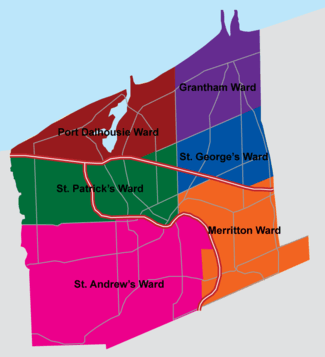
St. Catharines is governed by a mayor and city council of twelve city councillors, with two councillors representing each of the six municipal wards in the city. A city councillor is also elected by the council as a whole to serve as deputy mayor, who only fills the role should the elected mayor not be available. St. Catharines City Council meets every Monday and is open to participation by the community. Matters put forward are voted on by members of city council; the mayor presides over council debate and serves very much like the speaker, and as a result only votes in the case of a tie. After 2006, municipal elections will be in November every four years rather than the previous three. Unlike most cities its size, city councillors only serve on a part-time basis and continue with their non-political careers in the community. Only the mayor is elected to a full-time position. St. Catharines City Hall is downtown on Church Street. Tim Rigby was the Mayor of St. Catharines from 1997 to 2006; Brian McMullan was elected to succeed Rigby on 13 November 2006, and was sworn in on 4 December. He was re-elected in October 2010.[32] On 27 October 2014, Walter Sendzik was elected mayor of St. Catharines[33] and assumed office in December 2014.[34]
St. Catharines uses a council-manager government, and as a result a chief administrative officer (CAO) is appointed by council to oversee the day-to-day operations of the city and its departments. The CAO, in effect, is the highest ranking municipal civil servant and has authority over the spending of municipal tax dollars. The CAO advises council on policy matters and acts as liaison between the administrative staff and elected officials. Some of the CAOs duties include assisting in the creation of the municipal budget, and ensuring that municipal funds are spent in a responsible manner. Dan Carnegie is CAO, replacing Colin Briggs who retired in February 2014.
Residents of St. Catharines also elect six regional councillors to the Niagara Regional Council on an at-large basis. Unlike many other regional municipalities in Ontario, regional councillors do not sit on city council and instead only represent at the regional level. Four school board trustees for the District School Board of Niagara representing St. Catharines and Niagara-on-the-Lake are elected, as well as three trustees for the Niagara Catholic District School Board, two for five of St. Catharines' wards, and one for Thorold and the Merriton Ward of St. Catharines. Regional councillors and school board trustees are elected at the same time, and on the same ballot, as the mayor and city councillors.
St. Catharines has one of the lowest resident/representative ratios of any large city in Ontario. There are just under 7,000 people per elected municipal representative in St. Catharines, while Oshawa (a similar-sized city in Ontario) has one representative per 13,500 people. London, Ontario has one representative per 30,500 people, and Toronto has one representative per 109,280 people. There has been recent discussion regarding a modification of the city/regional council arrangement, with the possibility of reducing city council to six full-time representatives and having the six regional councillors serve on city council. While there is growing support in the business community for such an arrangement, city council has been unreceptive to such ideas.
Provincial
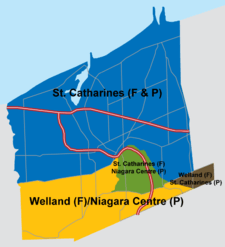
At the provincial level, St. Catharines is well known for electing high-profile members of the Legislative Assembly of Ontario. Jim Bradley, the member for St. Catharines until the 2018 provincial election and Ontario's longest serving Member of Provincial Parliament previously held numerous cabinet positions under Dalton McGuinty and Kathleen Wynne. Bradley recently celebrated 40 years in provincial politics.
Peter Kormos, who represented the southern portions of the city as part of the Welland riding, was a prominent Member of Provincial Parliament in the Ontario New Democratic Party caucus and served previously as Minister of Consumer and Commercial Relations in the Bob Rae government.
From 1999 to 2003, during the premierships of Mike Harris and Ernie Eves, St. Catharines was the only large city in Ontario to not have at least one government member representing the city, as the Progressive Conservative-held ridings of Lincoln and St. Catharines—Brock were eliminated as a cost-saving measure. Robert Welch, a long-time Deputy Premier of Ontario, represented the now-eliminated Lincoln and St. Catharines—Brock ridings throughout the 1960s, 1970s and 1980s.
Federal
Federally, St. Catharines is one of the most bellwether of any riding in Canada, having only elected an opposition MP twice in its history. Chris Bittle is the current MP for St. Catharines and is a member of the Liberal Party of Canada, which currently forms Canada's government. The southern portion of the city is included as part of the Niagara Centre riding, and is represented by Vance Badawey, a Liberal Party of Canada MP.[35] Most federal representatives from St. Catharines have maintained a low profile on either the government or opposition backbenches. The exception was Gilbert Parent, who served as Speaker of the House for seven years while Jean Chrétien was Prime Minister.
Legal
St. Catharines is the judicial seat of the Niagara North Judicial District of Ontario, Central South Region, which represents the northern half of the Niagara Region equivalent to historic Lincoln County. The Superior Court of Justice is on Church Street across from City Hall. A satellite court is in Grimsby.
The city forms "1 District" of the Niagara Regional Police Service. The NRPS headquarters are no longer on Church Street having moved to Niagara Falls in a finally constructed new building with administrative offices and support services on Cushman Road.
Transportation

The most defining transportation icon of St. Catharines is the Welland Canal, a ship canal that runs 43.4 kilometres (27.0 mi), passing through the city. Four of its locks are within city boundaries. The canal allows shipping vessels to traverse the 99.5-metre (326.5 ft) drop in altitude from Lake Erie to Lake Ontario.
The main access routes into and out of St. Catharines are served by two major freeways. The Queen Elizabeth Way runs east (at 15-Mile Creek) to west (at Garden City Skyway) and Highway 406 runs north (at QEW) to south (at St. David's Road). Prior to the construction of these freeways, St. Paul Street (former Highway 8, now Regional Road 81) and Hartzel Road (former Highway 58, now a city-maintained street) provided east–west and north–south access to the city.
Public transportation is served by the St. Catharines Transit Commission, which operates bus routes throughout the city and neighbouring Thorold. All major routes converge at the St. Catharines Bus Terminal, which is downtown within the headquarters of the Ontario Ministry of Transportation. The central station is also served by Greyhound Lines and Coach Canada, en route to Toronto and New York City and connecting it to major cities throughout Canada and the United States.
Though transportation by rail is becoming increasingly popular, the St. Catharines train station is largely underutilized, with car and bus travel being the dominant forms of transportation for the city. The station is in its original building, outside the downtown core (because of issues involving the crossing of 12-Mile Creek). It is served daily by Via Rail and Amtrak trains connecting it to Toronto and New York City. The provincial and federal government recently committed $385 million each to GO Transit to aid in the development of their 10-Year Capital Expansion Plan, which includes an expansion bus line servicing the Niagara Region. Currently, regular GO Bus service exists to St. Catharines with a stop at Fairview Mall, allowing riders to travel either west toward Burlington or east toward Niagara Falls. A rail link with GO Transit operates during the summer months with plans for the city to be permanently linked via rail in the future.
St. Catharines/Niagara District Airport services general aviation as well as chartered jetliner flights. The airport is served by charter flights from FlyGTA Airlines and offers charter flights to Billy Bishop Toronto City Airport, Muskoka and Collingwood. It is near the city's east-end in neighbouring Niagara-on-the-Lake. Other airports surrounding the city include Niagara Falls/Niagara South Airport and Niagara Central Dorothy Rungeling Airport. The closest airports in proximity offering long-haul and international flights are John C. Munro Hamilton International Airport, Niagara Falls International Airport and Toronto Pearson International Airport.
St. Catharines had one of the first interurban electric streetcar routes, which ran between the city and Merritton and was eventually extended to Port Dalhousie in the north and Thorold to the south. Like most streetcar routes throughout the world, it was decommissioned in the 1960s, and the right-of-way has since been converted to parks and trails.
Education
St. Catharines is home to Brock University (established 1964), a modern comprehensive university on the Niagara Escarpment. A partnership between the university and the Ontario Grape and Wine Industry established the city as a centre for cool-climate grape and wine research. Brock offers an Honours Bachelor of Science in Oenology and Viticulture.
Concordia Lutheran Theological Seminary, a post graduate institution of the Lutheran Church–Canada, operates on the campus of Brock University.
McMaster University's Michael G. DeGroote School of Medicine opened a satellite campus in St. Catharines in September 2008. The Hamilton, Ontario-based university educates 28 first-year medical students in local hospitals within the city.
Ridley College, near the city's downtown core in the Western Hill neighbourhood, is a distinguished co-educational boarding and day school. It was established as a boys' school in 1889, and became co-educational in 1973.
A campus of the Niagara College of Applied Arts and Technology is near the city's east end. Niagara College is the only fully licensed teaching winery in Canada. The "Niagara College Teaching Winery" (or NCT for short) has created award-winning wines. Niagara College has also taken home various medals from international wine competitions such as "Cuvee", "The Ontario Wine Awards" and "The Finger Lakes International Competition" to name a few. The school's Horticultural Campus was once on 360 Niagara Street in the 1970s–1990s but has since been relocated to Niagara-on-the-Lake. One of its greatest teachers, R. Roy Forster, was recognized with the Order of Canada on 14 April 1999, for his work in creating the VanDusen Botanical Garden in Vancouver, British Columbia.
The District School Board of Niagara (DSBN), responsible for managing a school system of nearly 119 faculties, contains 6 Secondary Schools in the city of St. Catharines, the DSBN Academy, Laura Secord Secondary School, Sir Winston Churchill, Governor Simcoe, St. Catharines Collegiate, Eden, and Harriet Tubman Public Elementary School.
The Niagara Catholic District School Board (NCDSB) manages 61 elementary and secondary schools within the Niagara Region and operates 3 Catholic Secondary Schools within the city, Holy Cross, Denis Morris Catholic High School, and Saint Francis.
The St. Catharines Public Library operates four branches in the city.[36]
Communities and development
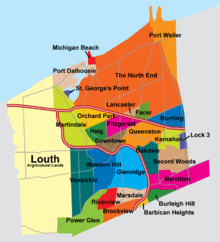

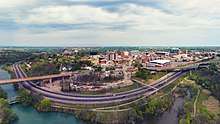
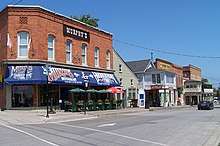
St. Catharines' development history has resulted in a number of unique and distinct communities within the city. The historical area of St. Catharines consisted of nothing more than what is now the downtown core, with the remaining land being part of Louth Township on the west and Grantham Township on the east. St. Catharines continued to steadily grow through the late 19th and early 20th centuries, eventually annexing land to the southwest that would become Western Hill and Old Glenridge, and to the east and north that would collectively become the central part of St. Catharines. In addition to the growth of St. Catharines, the Town of Merritton and the Town of Port Dalhousie existed as separate municipalities to the South and North of the city, each slowly growing their own residential base.
Along with the rest of Ontario, St. Catharines experienced explosive growth after World War II. St. Catharines continued to annex Grantham Township as development continued, including the large swaths of land to the north known now as "The North End". St. Catharines would also absorb Merritton and Port Dalhousie in 1961, making them part of the city. During this time, St. Catharines nearly tripled in population.
With the formation of the Regional Municipality of Niagara in 1970, the portion of Louth Township east of Fifteen Mile Creek was transferred to the City of St. Catharines. This included the eastern portion of the Hamlet of Rockway, as well as the Hamlet of Power Glen. The few remaining portions of Grantham Township in the Northeast corner of the area, including Port Weller, were also transferred to the city. With the new Louth Township lands belonging to the city, St. Catharines would begin two developments in the west end — Martindale in 1983, and Vansickle in 1987. These developments are nearing completion. There was also a push to continue further expansion to the west in the late 1990s, but this has since been halted by Ontario Greenbelt legislation.
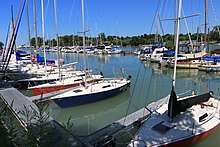
The following distinct communities exist within St. Catharines:
- North
- Bunting
- Facer
- Lancaster
- Michigan Beach
- The North End
- Port Dalhousie
- Port Weller
- St. George's Point
- Central
- Fitzgerald
- Haig
- Orchard Park
- Queenston
- Downtown St. Catharines
- West
- Martindale
- Power Glen
- Vansickle
- Western Hill
- East
- Kernahan
- Lock 3
- Merritton
- Oakdale
- Secord Woods
- South
- Barbican Heights
- Brockview
- Burleigh Hill
- Glenridge
- Marsdale
- Riverview
- Louth Agricultural Lands
Demographics
| Year | Pop. | ±% |
|---|---|---|
| 1841 | 3,500 | — |
| 1871 | 7,864 | +124.7% |
| 1881 | 9,631 | +22.5% |
| 1891 | 9,170 | −4.8% |
| 1901 | 9,946 | +8.5% |
| 1911 | 12,484 | +25.5% |
| 1921 | 19,881 | +59.3% |
| 1931 | 24,753 | +24.5% |
| 1941 | 30,025 | +21.3% |
| 1951 | 37,984 | +26.5% |
| 1961 | 84,472 | +122.4% |
| 1971 | 109,722 | +29.9% |
| 1981 | 124,018 | +13.0% |
| 1991 | 129,300 | +4.3% |
| 1996 | 130,926 | +1.3% |
| 2001 | 129,170 | −1.3% |
| 2006 | 131,989 | +2.2% |
| 2011 | 131,400 | −0.4% |
| 2016 | 133,113 | +1.3% |
| Ethnic Origin | Population | Percent |
|---|---|---|
| English | 40,430 | 31.09% |
| Scottish | 28,645 | 22.03% |
| Irish | 23,830 | 18.33% |
| German | 18,450 | 14.19% |
| French | 15,120 | 11.63% |
| Italian | 7,820 | 8.61% |
| Dutch | 7,820 | 6.17% |
| Polish | 6,940 | 5.47% |
| Ukrainian | 6,875 | 5.42% |
According to the 2011 census, there were 131,400 people residing in city of St. Catharines, located in the province of Ontario. In the five years between 2006 and 2011, the population of St. Catharines decreased by 0.4%, while Ontario as a whole grew by 5.7 percent.[37]
As of the 2006 census, 47.8% of the city's population were male and 52.2% were female. Minors (youth under the age of 19) totalled 22.6 percent of the population compared to pensioners who number 18.1 percent. This compares with the Canadian average of 24.4 percent (minors) and 13.7 percent (pensioners). The average age of St. Catharines residents is 41.7 compared to the Canadian average of 39.5.
As of the 2016 Canadian census, 84.7% of the population is White. Other groups include Black: 2.9%, Indigenous: 2.6%, Chinese: 2.1%, Latin American: 1.7%, and South Asian: 1.4%.[38]
Christianity is the dominant religion of the city. Some 81.0 percent of the population profess a Christian faith, the largest being various Protestant groups (42.9%), followed by Roman Catholicism (34.2%), while the remaining consists of Orthodox, and independent Christian groups. Non-Christian groups are also present, namely Islam (1.5%), Judaism (0.5%), and Buddhism (0.5%), and the city contains a synagogue and Jewish community centre as well a mosque. The remaining 16.5% report other or no religion.
Employment
- Employment rate: 58.2%
- Unemployment rate: 9.5%
- Average earnings: $26,997
Top five employers:
- District School Board of Niagara: 5,000
- General Motors: 2,653
- Niagara Health System: 1,800
- Brock University: 1,324
- Sitel: Approx. 1100
City issues
Like many large Canadian centres, a number of social issues affect the city:
Obesity
Since 1998, St. Catharines has had one of the highest obesity rates of any centre in Canada. A 2001 analysis by Statistics Canada showed that 57.3 percent of its residents were overweight.[39] This has caused some elements of the media, including CTV,[39] the Canadian Broadcasting Corporation[40][41] and The Globe and Mail[42] to dub St. Catharines as Canada's "fattest" city.
In 2008, new statistics were released that show that the percentage obese or obese/overweight residents of Hamilton (74.3%), Kingston (70.1%), and St. John's, Newfoundland and Labrador (70%) is now higher than St. Catharines-Niagara (69.3%), though the obesity rate in St. Catharines was higher in 2008 than in 1998.[43]
Poverty
The median total family income of $64,500 for the St. Catharines–Niagara census metropolitan area is the lowest in Ontario as of 2009.
Local media
Newspapers
- St. Catharines Standard (daily)
- Niagara This Week (community weekly)
- Canadian Stamp News (biweekly newspaper/philatelic journal)
- Canadian Coin News (biweekly newspaper/numismatic journal)
- The Brock Press (academic)
- St. Catharines Shopping News (commercial advertiser)
- SNAP St. Catharines
Radio
- AM 610: CKTB, news/talk
- AM 1220: CHSC, adult contemporary & Italian (This station lost its license in 2010 and is off the air now.)
- FM 97.7: CHTZ, active rock
- FM 103.7: CFBU, Brock University campus radio
- FM 105.7: CHRE (EZ Rock), adult contemporary
- 4680q : www.4680q.ca
In addition, numerous tourist and travel advisory stations are available off-air in the Niagara area.
Television
The Niagara region currently has no locally based television service of its own. Stations broadcasting from Toronto, Hamilton and Buffalo are available over-the-air in the region, and the region has a local transmitter (CKVP-DT) rebroadcasting the Barrie CTV 2 station CKVR-DT.
A local specialty news and information channel called Niagara News TV launched in February 2011, but ceased operations only 3 months later in April.
In 2003, a local business consortium applied to the Canadian Radio-television and Telecommunications Commission (CRTC) for a licence to operate TV Niagara, a community television station in St. Catharines. The application was denied by the CRTC in 2005, citing concerns about the group's business plan and its dependence on gaining audience share in the Toronto market. The organization's appeal to the Cabinet of Canada failed in 2006. The TV Niagara website remains to be updated; the last update occurred in 2006.
Online news
- Pulse Niagara
- The Niagara Independent
- Niagara this Week
- Niagara Region Info
- Niagara Sports News
- St. Catharines Standard
- SNAP St. Catharines
- Bullet News Niagara
- LocalSportsReport.com
- CanadianStampNews.com
- CanadianCoinNews.com
Twin and sister cities
Sports and leisure
Ice hockey
St. Catharines entered into the Ontario Hockey Association Junior 'A' Hockey in 1943 as the St. Catharines Falcons. In 1947, they became the Teepees and were affiliated with the American Hockey League's Buffalo Bisons. When the National Hockey League's (NHL) Chicago Blackhawks made the Bisons their number one farm team, they inherited the Teepees. In the 1960s, the Jr. 'A' team went deeply into debt to the Chicago Black Hawks, but continued as a successful franchise and were named the St. Catharines Black Hawks. The Hamilton Fincups moved to St. Catharines in 1976 and played here for one year before moving back to Hamilton. The AHL St. Catharines Saints played in St. Catharines between 1982 and 1986, before being forced to re-locate to Newmarket due to protests from the NHL Buffalo Sabres. The St. Catharines Saints served as the farm team for the Toronto Maple Leafs, and today are known as the Toronto Marlies.
In 2007, the OHL's Mississauga IceDogs relocated to St. Catharines and became the Niagara IceDogs. The IceDogs played out of the Jack Gatecliff Arena, which was renamed the Gatorade Garden City Complex. In 2014, the IceDogs moved to the newly built Meridian Centre. Since starting out the team has won the Emms Trophy in 2010–2011 & 2018–2019. They have also won the Bobby Orr Trophy during 2011–2012 season and 2015–2016 season, qualifying for the OHL Finals. They would be beaten both times by the London Knights. The team has had numerous NHL alumni including Alex Pietrangelo, Dougie Hamilton, Vince Dunn, Ryan Strome, Akil Thomas and Mark Visentin.
The St. Catharines Falcons play in the Golden Horseshoe Division of the Greater Ontario Junior Hockey League. The team has played since 1968 and plays all home games out of the Jack Gatecliff Arena. The team were runners up for the Sutherland Cup in 1979, 1990, 1994, 1997, 2000 and 2014, but won the cup in 2012.
Basketball
In 2015, the National Basketball League of Canada announced that Niagara had been awarded a new franchise to play in the Meridian Centre. The team, named the Niagara River Lions, began play in 2015 where they reached the conference quarterfinals. The team joined the Canadian Elite Basketball League after the 2017–18 season. The team has yet to have a successful season since joining the league.
Baseball
The city was the home of the New York–Penn League's St. Catharines Blue Jays, the Short-season A affiliate of the Toronto Blue Jays, from 1986 to 1999. In 1996 the team was renamed the St. Catharines Stompers, and was subsequently sold and relocated to Queens, New York City in late 1999, where they became the Queens Kings.
Rugby
St. Catharines Tigers RFC was formed in 1978. Beginning in 2015, the Tigers joined the Niagara Wasps RFC and play at their field in Thorold.
Soccer
The Canadian Soccer League's St. Catharines Wolves are one of the most successful professional soccer teams in Canada, and play at Club Roma in the west-end of the city.
Rowing
Martindale Pond in St. Catharines' Port Dalhousie is the site of the annual Royal Canadian Henley Regatta, a world-class event that brings over 3,000 athletes from various nations to the city. The site hosted the FISA World Rowing Championships in 1970 and in 1999. More recently, the World Master's Rowing Championship was held at the Martindale Pond in the summer of 2010, with $500,000 in improvements to the facility such as: a weed harvester, new docking and a new timing system. There are currently talks to bring the Canadian Rowing Hall of Fame to St. Catharines sometime in the near future. The pond is also home to the St. Catharines rowing club, Brock University rowing club, Ridley College rowing club and to the annual CSSRA Championships, which draws hundreds of high school athletes from Canada, the U.S. and Mexico. The Martindale Pond or Henley, continues to hold its world-renowned status as a major rowing venue in the world. The rowing event in the Pan American Games were held in St. Catharines in 2015. Several Olympic medallists in rowing are from St. Catharines, including Melanie Kok, Buffy Williams, and Dave Boyes.
Sailing
There are marinas at Port Dalhousie and Port Weller and a club that sails from Municipal Beach. The St. Catharines Marina is at Port Weller. The Port Dalhousie Pier Marina and the Port Dalhousie Yacht Club are at Port Dalhousie.
Trail system
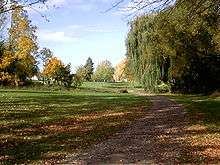
The city's trail system offers over 90 kilometres (55 mi) of accessible pathways that are suitable for walking, jogging, cycling, hiking and cross-country skiing.
- Bruce Trail: Canada's oldest and longest hiking trail, following the Niagara Escarpment (designated as a UNESCO World Biosphere Reserve site) from Niagara-on-the-Lake to Tobermory. A 20-kilometre (12 mi) section with associated side trails winds through St. Catharines passing by places such as the Morningstar Mill.
- Merritt Trail: a segmented 11 km (6.8 mi) trail that passes many of the old sections of the second Welland Canal and remnants of its locks.
- Terry Fox Fitness Trail: named after Canadian hero Terry Fox, a 1.5 km trail that runs along the former interurban railway right-of-way through central St. Catharines. Placed strategically along the Terry Fox Fitness Trail are six exercise stations of Dynatract Fitness Course, with instruction boards at each station.
- Waterfront Trail: follows the shore of Lake Ontario, connecting communities from Niagara-on-the-Lake to Brockville. The Port Dalhousie portion of the trail is a major highlight.
- Welland Canals Parkway: provides an uninterrupted 9-kilometre (5.6 mi) paved path for non-motorized traffic, along the western side of the scenic Welland Canal. It links with the waterfront trails of Niagara-on-the-Lake and Port Colbourne, and the Niagara Parkway to create the Greater Niagara Circle Route, measuring approximately 150 kilometres (90 mi). An equestrian trail is on the canal's east side and is part of the parkway.
Arts and culture
Art galleries
St. Catharines is home to a number of notable art institutions. These include the Rodman Hall Art Centre, a contemporary art gallery of Brock University located in the former home of prominent local business leader and House of Commons of Canada member Thomas Rodman Merritt;[45] the CRAM Collective;[46] and the Niagara Artists Centre.[47]
Festivals

The Folk Arts Festival was first presented to the city by representatives from the ethno cultural communities of Niagara over 35 years ago. From that first festival was created the Folk Arts Council of St. Catharines, which continues to run its festival each year throughout the month of May and concludes with "Folk Arts in the Park", which takes place in Montebello Park in the city's downtown.
The Art of Peace Festival is now in its fifth year, the Festival seeks to increase community engagement in art as a tool for reflecting on peace issues. Montebello Park fills with performing arts events, Speak Your Peace! open mic program, community art workshops, an elementary school art exhibition, vendors, and Peace Through Art Stations at which peace groups make information available and offer arts activities. Presented by St. Catharines and Area Arts Council and Project Ploughshares Niagara.
The Niagara Grape & Wine Festival is a non-profit organization that presents three wine festivals in St. Catharines and Niagara during the year. The Niagara Icewine Festival (Winter), the Niagara New Vintage Festival (Summer), and the Niagara Wine Festival (Fall), which is the largest of the festivals, attract hundreds of thousands of visitors to the region each year. This event known by most locals simply as "Grape and Wine" attracts young and old varying from partiers to wine connoisseurs.
The SCENE Music Festival was a one-day event held in various clubs and pubs downtown. Rock, indie, pop, singer-songwriter, ska, punk, metal, and many other genres were represented by bands such as Alexisonfire, Bedouin Soundclash, Moneen, Del Tha Funky Homosapien, Shad, Raising the Fawn, Supergarage, IllScarlett, Silverstein, Dead and Divine, Teenage Head, Cancer Bats, The New Cities, Lights, Madball, Billy Talent, Crippling Ozone, and Down with Webster who have played at the festival. Traditionally, a compact disc of select performers was included with admission prices — although in later years the CD was expanded to a 2-disc compilation — representative of the growth of the festival. SCENE 2008 and SCENE 2009 included a card with a PIN enabling 50 MP3 downloads, instead of CD's. The most recent occurrence of the festival was in 2014.
The International Chicken Chucking Championships takes place every January in the St. Catharines neighbourhood of Port Dalhousie and attracts hundreds of participants and observers.[48] Chicken Chucking consists of pitching or sliding frozen chickens along the ice-covered Martindale Pond, similar to curling and shuffleboard. The fundraiser began in 2000 by patrons of the Kilt and Clover after realizing that there was not much to do in Port Dalhousie in the middle of winter. The Kilt and Clover hosts the event, and the money raised is given to local charities, including the food bank.
Museums
The St. Catharines Museum is at Lock 3 on the Welland Canal, off the Welland Canals Parkway. An elevated viewing platform at the museum allows visitors to get a close-up look at ships from around the world as they climb this major section of the St. Lawrence Seaway. Along with its exhibits dedicated to the city's history and the canals, the museum is home to the Ontario Lacrosse Hall of Fame and Museum.
Morningstar Mill, perched atop the Niagara Escarpment, is one of Ontario's oldest mills on an original site, and is fully powered by water. The picturesque park provides a glimpse into the innovative and pioneering spirit of the 19th Century.
The YMCA Discovery Centre (formerly The Children's Discovery Centre of Niagara), in the former Niagara College Horticulture School, provides children and their families with an educational yet entertaining and stimulating place to visit using hands-on, interactive exhibits and outdoor activities.
Theatres
Performance theatre
St. Catharines is also home to a variety of theatre companies. These companies include Garden City Productions (formerly the Operatic Society of Grantham United Church 1956–1962), Carousel Players (in the Old Courthouse), Mirror Theatre, Essential Collectives Theatre, and the Empty Box Theatre Company.
The FirstOntario Performing Arts Centre[49] opened in the fall of 2015.[50] Located on St. Paul Street, in the down town core, it features four performance spaces in one venue including cinemas and dance halls. The Centre plays hosts to many events including theatrical events, concerts, children's based events, ballet, comedy shows and more.
Cinema
In the South end of the city, at the Pen Centre Shopping Mall, Landmark Cinemas features ten screens. Landmark Cinemas presents the latest movie hits as well as the Metropolitan Opera Series.[51] The Canview Drive in is a four-screen drive in theatre located in nearby Thorold, Ontario operating throughout the summer months. Other cinemas in proximity include Cineplex operating in Niagara Falls and Welland.
Fairview Mall opened a Cineplex Odeon theatre in 1994 with five screens. Four more screens were added in 1997. In late 2006, despite the theatre's success, the mall's landlord decided to terminate the theatre's lease in order to provide space for a new Winners discount store in the mall, despite the objections of Cineplex. The theatre played its last shows on 25 January 2007.[52]
Downtown, at the FirstOntario Performing Arts Centre, The Film House runs 8–10 screenings a week. The Film House aims to present diverse narratives, with themed or genre-specific nights.[53]
Shopping
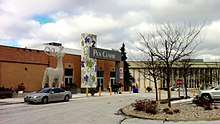
- The Pen Centre: largest shopping mall in the Niagara Peninsula
- Fairview Mall
- Smart!Centres (formerly First Pro Garden City)
- Lincoln Mall: demolished, replaced by Lincoln Value Centre
- Downtown Farmers Market
- Outlet Collection at Niagara, located in Niagara-on-the-Lake
- Merritt Street, South St. Catharines (Downtown Merritton)
Notable people
References
- "St. Catharines, Ontario census profile". 2016 Census of Population. Statistics Canada. Archived from the original on 17 March 2017. Retrieved 4 March 2017.
- "St. Catharines, Ontario (Code 3526053) census profile". 2011 Census of Population. Statistics Canada. Archived from the original on 18 July 2013. Retrieved 20 August 2012.
- "St. Catharines – Niagara (Population Centre), Ontario (Code 0788) census profile". 2011 Census of Population. Statistics Canada. Archived from the original on 18 March 2014. Retrieved 20 August 2012.
- "St. Catharines – Niagara (Census metropolitan area), Ontario (Code 539) census profile". 2011 Census of Population. Statistics Canada. Archived from the original on 2 April 2015. Retrieved 20 August 2012.
- "St Catharines Power Glen". Canadian Climate Normals 1981–2010. Environment Canada. Retrieved 15 September 2013.
- "Growth Plan for the Greater Golden Horseshoe 2017" (PDF). placestogrow.ca. Archived (PDF) from the original on 6 April 2018. Retrieved 2 May 2018.
- National Archives of Canada RG 19 Vol 4447 Parcel 3
- Wilson, Bruce (1983). The Enterprises of Robert Hamilton
- Wilson, Bruce (2000)"Hamilton, Robert". Archived from the original on 17 October 2012. Retrieved 26 November 2010.
- https://archive.org/stream/stgeorgesparish00unknuoft#page/24/mode/2up Archived 3 April 2015 at the Wayback Machine "Assignment to the Church at St. Catherines" 17 February 1796; St. Georges Church Archives, St. Catharines, ON.
- Merritt, Jedediah Prendergast (1875). Biography of the Hon. W. H. Merritt, M. P.: Of Lincoln, District of Niagara, Including an Account of the Origin, Progress and Completion of Some of the Most Important Public Works in Canada. E. S. Leavenworth, book and job printing establishment. p. 49.
- Merritt, Jedediah Prendergast (1875). Biography of the Hon. W. H. Merritt, M. P.: Of Lincoln, District of Niagara, Including an Account of the Origin, Progress and Completion of Some of the Most Important Public Works in Canada. E. S. Leavenworth, book and job printing establishment. p. 6.
- Ontario Historical Society, Papers & Records Vol. XXXVI (1975), "The Petition of John Hainer and Jacob Dittrick, page 201" and Upper Land Petitions " H " Bundle 3, 1797 (National Archives of Canada RG1 L3 Vol. 224)
- Smith, Wm. H. (1846). SMITH'S CANADIAN GAZETTEER – STATISTICAL AND GENERAL INFORMATION RESPECTING ALL PARTS OF THE UPPER PROVINCE, OR CANADA WEST:. Toronto: H. & W. ROWSELL. pp. 177–178.
- "Harriet Tubman House". Harriet Tubman Historical Society. Retrieved 18 March 2020.
- "Harriet Tubman and her connection to a small church in Ontario". Public Radio International. Retrieved 18 March 2020.
- "St. Catharines museum marks Black History Month". Niagara This Week. Archived from the original on 7 November 2017. Retrieved 21 February 2017.
- "Register of the Government of Canada Heritage Buildings". pc.gc.ca. Retrieved 2 May 2018.
- Peel, M. C. and Finlayson, B. L. and McMahon, T. A. (2007). "Updated world map of the Köppen–Geiger climate classification" (PDF). Hydrol. Earth Syst. Sci. 11 (5): 1633–1644. doi:10.5194/hess-11-1633-2007. ISSN 1027-5606. Archived (PDF) from the original on 3 February 2012.CS1 maint: multiple names: authors list (link)
- "About Our City". City of St Catharines. Archived from the original on 17 October 2015. Retrieved 22 September 2015.
- "St Catharines". Canadian Climate Normals 1961–1990. Environment Canada. Archived from the original on 16 August 2016. Retrieved 1 July 2016.
- "St Catharines Airport, Ontario". Canadian Climate Normals 1981–2010. Environment Canada. Archived from the original on 17 February 2015. Retrieved 16 February 2015.
- "St Catharines Airport, Ontario". Canadian Climate Normals 1981–2010. Environment Canada. Retrieved 16 February 2015.
- nurun.com. "City makes pitch to have wine route redirected ... | St. Catharines Standard". stcatharinesstandard.ca. Archived from the original on 10 September 2012. Retrieved 15 April 2016.
- nurun.com. "Wine route is moving downtown | St. Catharines Standard". stcatharinesstandard.ca. Archived from the original on 18 September 2012. Retrieved 15 April 2016.
- nurun.com. "Two-way traffic returns to downtown | Welland Tribune". wellandtribune.ca. Archived from the original on 15 January 2013. Retrieved 15 April 2016.
- "Taking a u-turn on the one-way street | National Post". news.nationalpost.com. 8 January 2012. Archived from the original on 16 June 2016. Retrieved 15 April 2016.
- nurun.com. "Funding announced for downtown performing arts ... | St. Catharines Standard". stcatharinesstandard.ca. Archived from the original on 15 January 2013. Retrieved 15 April 2016.
- "St. Catharines approves new spectator facility". Archived from the original on 18 July 2012.
- nurun.com. "No arena, no IceDogs | St. Catharines Standard". stcatharinesstandard.ca. Archived from the original on 3 December 2011. Retrieved 15 April 2016.
- "Put it in park in the new Carlisle Street Parking Garage" (PDF). Archived (PDF) from the original on 14 July 2014. Retrieved 15 November 2011.
- Bergsma, Marleen (25 October 2010). "Brian McMullan takes St. Catharines mayor's seat with decisive victory". St Catharines Standard. Archived from the original on 22 February 2014. Retrieved 18 February 2014.
- Sawchuck, Bill (28 October 2014). "Sendzik seals the deal". St. Catharines Standard. Archived from the original on 6 August 2016. Retrieved 18 July 2016.
- Walter, Karena (1 December 2014). "Sendzik vows to bring "hometown pride" back to city". St. Catharines Standard. Archived from the original on 6 August 2016.
- LaFleche, Grant. "Dykstra, Allen lose their seats". St. Catharines Standard. Archived from the original on 21 October 2015. Retrieved 23 October 2015.
- "Locations & Hours". St. Catharines Public Library. Retrieved 28 October 2018.
- "St. Catharines (City) community profile". 2006 Census data. Statistics Canada. Archived from the original on 12 June 2012. Retrieved 3 February 2011.
- Government of Canada, Statistics Canada (8 February 2017). "Census Profile, 2016 Census – St. Catharines, City [Census subdivision], Ontario and Niagara, Regional municipality [Census division], Ontario". www12.statcan.gc.ca.
- "St. Catharines tops list of Canada's 'fattest' cities. W-Five, July 21, 2001". ctv.ca. Archived from the original on 28 March 2007. Retrieved 2 May 2018.
- "CBC.ca, National Population Health Survey 1998, Statistics Canada". cbc.ca. Archived from the original on 21 July 2012. Retrieved 2 May 2018.
- "CBC.ca, Obese Nation: Statistics, November 8, 2006". cbc.ca. Archived from the original on 15 November 2004. Retrieved 2 May 2018.
- Picard, André (21 July 2001). "Fattest & Fittest, St. Catharines leads the fat parade". The Globe and Mail. Archived from the original on 2 February 2007 – via andrepicard.com.
- "Regional differences in obesity" (PDF). Statistics Canada.
- "Listing of Twinning Cities – City of Port of Spain". cityofportofspain.gov.tt. Archived from the original on 22 October 2017. Retrieved 2 May 2018.
- "Rodman Hall Art Centre". Brock University. Retrieved 18 March 2020.
- "CRAM International". Retrieved 18 March 2020.
- "Niagara Artists Centre". Retrieved 18 March 2020.
- Walter, Karena (17 January 2009) "Time for a poultry-pitching party", The St. Catharines Standard. Retrieved 27 December 2009.
- "The New Performing Arts Centre". Archived from the original on 1 August 2015. Retrieved 27 July 2015.
- Walter, Karena (15 November 2015). "Arts centre opening draws large crowd". St. Catharines Standard. Archived from the original on 17 November 2015.
- "Movie Showtimes & Listings in St. Catharines, Ontario | Landmark Cinemas". landmarkcinemas.com. Archived from the original on 4 August 2016. Retrieved 15 April 2016.
- "Cineplex Odeon Fairview Mall Cinemas". Cinema Treasures. Archived from the original on 8 August 2017. Retrieved 8 August 2017.
- Walter, Karena (21 February 2016). "Movies set to premiere in downtown St. Catharines". St. Catharines Standard. Archived from the original on 6 March 2016. Retrieved 3 March 2016.
- Extreme high and low temperatures were recorded at St. Catharines (January 1911 to May 1971) and at St. Catharines Airport (June 1971 to present).
External links
| Wikimedia Commons has media related to St. Catharines, Ontario. |
| Wikivoyage has a travel guide for St. Catharines. |


